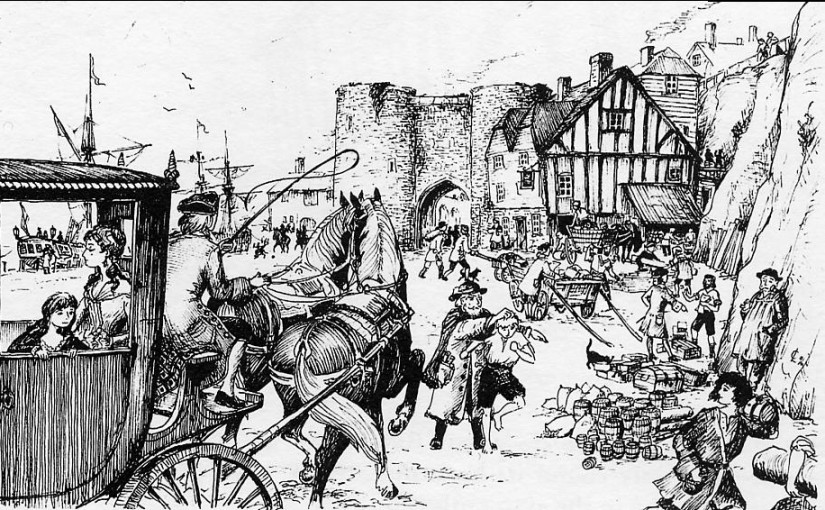A description of Rye by Barbara Ballard claims that the word Rye is a corruption of an old Anglo- Saxon word meaning an island. Sounds a quite feasible explanation. There have been others of course, the favourite Rhee, meaning shelter but island does sound convincing. Barbara Ballard’s description of Rye off the “Postcard of Britain website is quite descriptive too. “Rye’s historic core, sited on a hill overlooking a landscape of green pastures, was once almost enveloped by the sea. Its position on a narrow neck of land with the wide estuaries of the Tillingham and Rother rivers on each side was significant. It could watch over the surrounding Romney Marsh, and, as a port, it guarded the land from foreign invasion. Still the French were able to burn most of the town in 1377. Three years later the building of huge perimeter stone defences began. Today only the northern entrance, 40-foot high Land Gate, remains intact.
Rye was designated a head Cinque Port in 1336. Cinque Ports were an ancient confederation of harbours used for defence by Edward the Confessor. Rye supplied ships for the navy. The harbour began silting up in the late 1300’s and by the 1600’s the silting became severe. Today the harbour mouth is two miles away.
Secret passageways, steep cobbled streets, old half-timbered buildings, red-tiled roofs and ruined walls transport one back in time. Cobbled Mermaid Street’s medieval buildings mix with Georgian ones. The 15th century Mermaid Inn, originally built of wattle, daub and plaster, but destroyed in the French burning of the town, sports a Norman cellar made of rock with a barrel vaulted ceiling of ships’ timbers and Sussex oak. Old beams and inglenook fireplaces give authenticity to its age. In the 1300’s lodging could be had for a penny a night.
This innocent looking inn was once a haunt for a ruthless group of 600 smugglers, the Hawkshead (Hawkhurst) Gang. They were not above intimidation of the authorities and had the locals in their power. Wool was smuggled out in the 1600’s and wine, brandy, tobacco and lace were brought in. Even coffee and chocolate were among the smuggled goods.
” Rather a good explanation of Rye’s past.
More of Barbara Ballard’s descriptive information about Rye can be obtained by looking up “Post Cards from Britain” on the web.
“Rye’s Own” January 2004
All articles, photographs, films and drawings on this web site are World Copyright Protected. No reproduction for publication without prior arrangement. © World Copyright 2015 Cinque Ports Magazines Rye Ltd., Guinea Hall Lodge Sellindge TN25 6EG
